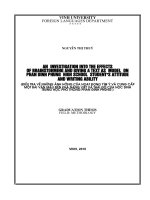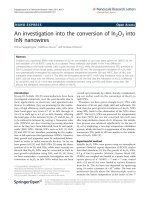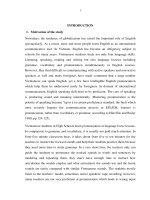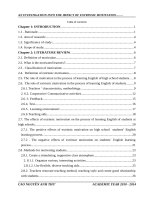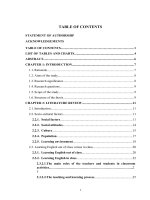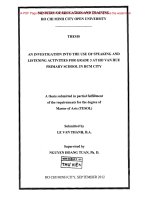Investigation into the roles of ataxia telangiectasia mutated gene product, in multiple BRCA backgrounds
Bạn đang xem bản rút gọn của tài liệu. Xem và tải ngay bản đầy đủ của tài liệu tại đây (1.43 MB, 100 trang )
INVESTIGATION INTO THE ROLES OF ATAXIA
TELANGIECTASIA MUTATED GENE PRODUCT, IN
MULTIPLE BRCA BACKGROUNDS
HIONG KUM CHEW
NATIONAL UNIVERSITY OF SINGAPORE
2007
INVESTIGATION INTO THE ROLES OF ATAXIA
TELANGIECTASIA MUTATED GENE PRODUCT, IN
MULTIPLE BRCA BACKGROUNDS
HIONG KUM CHEW
(B.Sc., NUS)
A THESIS SUBMITTED
FOR THE DEGREE OF MASTER OF SCIENCE
DEPARTMENT OF PHYSIOLOGY
YONG LOO LIN SCHOOL OF MEDICINE
NATIONAL UNIVERSITY OF SINGAPORE
2007
ACKNOWLEDGEMENTS
I would like to take this rare opportunity to express my deepest gratitude to my
supervisor, Dr Srividya Swaminathan for her guidance, support, and encouragement
during the course of my study and all the help rendered in completion of the thesis. It
wouldn’t be possible without her.
My sincere appreciation goes to the present and ex-staff members of Oncology Research
Institute (ORI): Tada, Tomoko, Tun Kiat, Tiling, Angela, Fenyi, Peiyi, Baidah and
Diyanah, for their wonderful friendship and continuous support in me. Special thanks go
to my pretty group members: Dianne, Jawshin, Deepa and Joyce for their partnership and
help. It is really a great pleasure to be working with them. This also extends to the Breast
Cancer Group especially to Weiyi, Emily and Huiyin for their great company.
I want to thank Prof Yoshiaki Ito of ORI for his support in my graduate studies and also
allowing me to use the facilities and reagents. I also thank A/Prof Prakash Hande for
providing me the AT-Tert cells for my project. I am grateful for the research scholarship
provided by NUS and giving me this opportunity to pursue graduate study.
Finally, I am most grateful and indebted to my parents for their unconditioned love and
concern for me all these years. Most importantly, they believe and gave me all the
support I need to pursue my dreams.
Once again, Thank You.
i
TABLE OF CONTENTS
ACKNOWLEDGEMENTS
i
LIST OF FIGURES
vi
LIST OF TABLES
viii
LIST OF ABBREVIATIONS
ix
SUMMARY
xi
1.
INTRODUCTION
1.1.
Ataxia Telangiectasia Mutated
1
1.2.
ATM mediated signaling
3
1.3.
ATM and DNA damage responses
4
1.4.
ATM and telomere stability
7
1.5.
Clinical significance of ATM loss
8
1.6.
Objectives
9
1.7.
Approaches
1.7.1.
Bacterial Artificial Chromosomes (BAC) recombineering 10
1.7.2. RNA interference
2.
11
MATERIALS AND METHODS
2.1.
Reagents
13
2.2.
Cell Lines
13
2.3.
Vectors
14
2.4.
BAC engineering
2.4.1. Targeting vector design
14
2.4.2. Preparation of competent cells and electroporation
15
ii
3.
2.4.3. Screening for recombinants
16
2.5.
Transfection
17
2.6.
RNA extraction and first stand cDNA synthesis
17
2.7.
Quantitative PCR (qPCR)
18
2.8.
SuperArray analysis
18
2.9.
Western Blot
19
2.10.
Immunoprecipitation
20
2.11. Genotoxin sensitivity assays
20
2.12.
Soft agar assay
21
2.13.
Immunohistochemistry
21
RESULTS
3.1.
Generation of altered alleles of ATM deletion
23
3.2.
Missense transfected AT-Tert cells exhibit altered growth
30
characteristics
3.3.
Screening and verification of ATM knockdowns
33
3.4.
Gamma-irradiation reduces cell viability in HeLa and
34
Capan-1 ATM knockdowns but not in HCC1937 background
3.5
ATM knockdowns are more susceptible to damage by
37
alkylating and crosslinking agents
3.6.
Gamma irradiation induced Chk2 phosphorylation is
42
compromised in the ATM knockdowns
3.7.
Etoposide induces Chk2 expression and phosphorylation in
45
untransfected HeLa, HCC1937 and Capan-1 cells
iii
3.8.
ATM knockdowns in HeLa and Capan-1 but not HCC1937
46
show reduced Chk2 expression and phosphorylation
after etoposide treatment
3.9.
ATM knockdowns exhibits different gene expression profiles
50
in different backgrounds in comparison to control
3.10.
Interaction of ATM with BRCA2
51
3.11.
Knockdown of ATM promotes anchorage-independent growth
53
in soft agar assay only in a BRCA2 null background
3.12.
Gamma-irradiation reduces colony forming ability in
59
HeLa but not Capan-1 ATM knockdowns
4.
DISCUSSION
4.1.
Generation of altered alleles of ATM
62
4.2.
Generation of ATM knockdowns in multiple BRCA backgrounds 64
4.3.
Effects of ATM knockdown on cell survival
65
4.4.
Effects of drug treatment on the ATM KD
66
4.5.
Effects of ATM loss on irradiation induced regulation
67
and phosphorylation of Chk2
5.
4.6.
Effects of etoposide treatment on the regulation of Chk2
68
4.7.
Effects of KD on cellular transformation in a soft agar assay
69
4.8.
Cellular involvements of ATM
70
4.9.
Possible interaction of ATM with BRCA2
72
CONCLUSION
74
iv
6.
FUTURE DIRECTIONS
76
7.
REFERENCES
77
8.
APPENDIXES
Appendix 1
Relative expression profile of ATM knockdown
81
clones in various backgrounds
Appendix 2
Effects of etoposide treatment on ATM expression
Appendix 3A BRCA1 expression in HeLa and HCC1937 assessed
82
83
by immunofluorescence
Appendix 3B BRCA2 expression in HeLa and Capan-1 assessed
84
by immunofluorescence
Appendix 4
Chemical composition of media
85
Appendix 5
Images of AT-Tert BACAtm (missense) cells
86
during and after selection
v
LIST OF FIGURES
Figure 1
Representation of ATM protein depicting various regions of
possible function or interaction.
3
Figure 2
Assessment of transformation efficiency after electroporation
in the missense clones by 2 step PCR.
25
Figure 3
Results of mismatch PCR on row and column pools (missense).
26
Figure 4
Sequencing of BACAtm to confirm the missense generation.
27
Figure 5
Assessment of transformation efficiency after electroporation
in the deletional clones by 2 step PCR.
28
Figure 6
Results of mismatch PCR on row and column pools (deletion).
29
Figure 7
Sequencing of BACAtm to verify the deletion of the FATC
domain.
30
Figure 8
Multiple representative images of control and transfected
AT-Tert cells.
31
Figure 9
Growth of AT-Tert and AT-Tert (BACAtm deletion) cells.
32
Figure 10
Screening for ATM knockdowns by quantitative PCR
and western blotting.
34
Figure 11
MTT assay in various cell lines and their ATM knockdowns
after γ-irradiation.
36
Figure 12
MTT assay in various cell lines and their ATM knockdowns
after BCNU treatment.
39
Figure 13
MTT assay in various cell lines and their ATM knockdowns
after MMS treatment.
40
Figure 14
MTT assay in various cell lines and their ATM knockdowns
after MMC treatment.
41
Figure 15
Western blot detection in HeLa and AT-Tert cells before
and after γ-irradiation.
43
Figure 16
Western blot detection in HeLa, HCC1937, Capan-1
and their ATM knockdown clones after γ-irradiation.
44
vi
Figure 17
Western Blot for detection in HeLa, HCC1937 and Capan-1
cells after etoposide treatment.
46
Figure 18
Western blot detection in HeLa and the ATM knockdowns
after etoposide treatment.
47
Figure 19
Western blot detection in HCC1937 and the ATM knockdowns
after etoposide treatment.
48
Figure 20
Western blot detection in Capan-1 and the ATM knockdowns
after etoposide treatment.
49
Figure 21
Expression profile of ATM knockdown on different BRCA
backgrounds.
51
Figure 22
Immunoprecipitation of ATM and BRCA2.
53
Figure 23
Representative images various cell lines and their ATM
knockdowns in a soft agar assay.
55
Figure 24
Colony formation assay for ATM knockdowns after
exposure to γ-irradiation.
61
vii
LIST OF TABLES
Table 1
Number of colonies in the controls and ATM knockdowns
54
observed in a soft agar assay.
viii
LIST OF ABBREVIATIONS
AT
Ataxia Telangiectasia
ATM
Ataxia Telangiectasia Mutated
BAC
Bacterial artificial chromosomes
BCNU
3-bis-(2-chloroethyl)-1-nitrosurea
BRCA1/BR1
Breast Cancer Susceptibility Gene 1
BRCA2/BR2
Breast Cancer Susceptibility Gene 2
cDNA
Complementary DNA
dsRNA
Double stranded RNA
gDNA
Genomic DNA
Gy
Gray
h
hour
IgG
Immunoglobulin G
IP
Immunoprecipitation
IR
Irradiation
kb
Kilobase(s)
KD
Knockdown
kDa
Kilodalton
LB Cm+
Luria Bertani broth supplemented with 20μg/ml Chloramphenicol
min
minutes
MMC
Mitomycin-C
MMS
Methyl methanesulfonate
mRNA
Messenger RNA
PBS
Phosphate buffered saline
PCR
Polymerase Chain Reaction
PI3K
Phosphatidylinositol 3-kinase
qPCR
Quantitative PCR
s
seconds
siRNA
Short interfering RNA
shRNA
Short hairpin RNA
Tert
Telomerase
ix
1x TE
10 mM Tris (pH 8.0), 1 mM EDTA
x
SUMMARY
ATM is a serine-threonine kinase that is activated in response to DNA double strand
breaks and is an important sensor for proper repair. Individuals with biallelic mutations in
ATM have a fivefold increased risk of developing leukemia or lymphoblastic lymphomas.
Recent investigations reveal that Ataxia-telangiectasia (AT) mutation carriers have an
increased risk of developing breast cancer, especially in younger women. To understand
further the interplay between ATM and breast cancer susceptibility genes, we initiated
studies to investigate the contribution of simultaneous loss of ATM and BRCA function
in multiple cell culture based models. We utilized various approaches to investigate the
role of ATM in multiple BRCA backgrounds including RNA interference, clonogenic
survival and Bacterial Artificial Chromosome engineering to study downstream signaling
efficiency, sensitivity to therapy, cell cycling and transformability.
ATM missense and deletion near the PI3-kinase domain was created by BAC
recombineering and used to transfect into ATM null cells (AT-Tert) to study its function.
Missense mutation expression appears to dramatically affect long term survival of ATTert cells in culture. Deletion of the FATC domain in ATM on the other hand, did not
affect cell survival or dramatically alter growth in culture suggesting that basal level of
kinase function is maintained. The missense allele however functions as a dominant
negative and seems to have a dysregulatory effect on telomerase function.
xi
ATM knockdowns in various BRCA backgrounds were achieved by RNA interference.
ATM-mediated Chk2 signaling in all the cell lines tested correlated directly with the
levels of ATM knockdown achieved. However when assessed for short term survival
after genotoxic drugs (BCNU, MMS and MMC) treatment or gamma irradiation, various
BRCA backgrounds exhibited differential sensitivity and survival responses.
Assessment of the expression profile of the knockdown and control cells using a PCR
array of 84 genes involved in the cell cycle pathway revealed that Bcl2, p21, Cul2 and
Rad9 were differentially regulated. Their altered expression may provide explanations for
the differential responses observed on ATM knockdown in cells further compromised for
BRCA functions.
Taken together, our data suggests that ATM may regulate other signaling pathways via its
ability to interact with BRCA1 and/or BRCA2 and that loss of multiple functions, often
seen in cancers, could drive cellular transformation and influence responses to therapy.
xii
1.
INTRODUCTION
1.1.
Ataxia Telangiectasia Mutated
Ataxia-telangiectasia (AT) is an autosomal recessive condition with an estimated
frequency of 1 in 40,000 to 1 in 300,000 in Caucasian populations (Swift et al., 1986). It
is characterized by progressive cerebellar ataxia, oculomotor apraxia, choreoathetosis,
telangiectasias of the conjunctivae, immunodeficiency, frequent infections, an increased
risk of malignancy and sensitivity to ionizing radiation (Chun and Gatti, 2004; Taylor and
Byrd, 2005). AT individuals are estimated to have a 100-fold increased risk of cancer
compared with the general population. Lymphoid cancers predominate in childhood, and
epithelial cancers, including breast cancer, are seen in adults (Morrell et al., 1986). Over
10% of AT patients develop cancer at an early age. Thorstenson et al. (2003) mapped 137
sequence alterations in the ATM gene from 270 Austrian hereditary breast cancer or
ovarian cancer families.
Individuals heterozygous for ATM, about 1% of the general population, may have an
increased predisposition to cancer, in particular breast cancer. AT carriers have been
shown to be 5.5 times more likely to develop breast cancer than non-carriers. It is likely
that the risks are higher for some mutations, especially missense mutations expressing
abnormal protein.
1
The gene for ataxia-telangiectasia (ATM) was mapped to chromosome 11q by genetic
linkage analysis in 1988 and was identified by positional cloning in 1995 (Gatti et al.,
1988; Savitsky et al., 1995). The ATM gene is located at chromosome 11q22.3 and
consists of 66 exons, 64 of which encode a protein of 3056 amino acids (Savitsky et al.,
1995).
ATM belongs to a protein family known as the PI3K-related protein kinases (PIKK)
(Abraham, 2004). These proteins are characterized by a domain similar to that in
phosphatidylinositol 3-kinase. Most PIKKs including ATM, are active serine/threonine
kinases. ATM also contains a FAT domain (FRAP, ATM, TRAPP), and a highly
conserved C-terminal FATC domain (Bosotti et al., 2000). The FATC domain appears to
be important for regulating the kinase activity of ATM and for binding regulatory
proteins (Jiang et al., 2006). The N-terminal regions of ATM include several HEAT
domains that may influence interactions with other proteins (Perry and Kleckner, 2003)
and a region essential for substrate binding (Fernandes et al., 2005). Other putative
motifs, including an incomplete leucine zipper and a proline-rich region that binds c-Abl,
have been reported, but are less well characterized (Lavin et al., 2004).
2
Fig 1: Representation of ATM protein depicting various regions of possible function or
interaction. The kinase activity attributable to the PI3-kinase domain of ATM is currently
its only established function. (adapted from Lavin et al., 2004)
1.2.
ATM mediated signalling
ATM plays a central role in the repair of DNA double-strand breaks. The response to
DNA damage includes numerous processes such as recognition of damaged DNA,
recruitment of repair proteins, signalling to cell cycle checkpoints, transcriptional
regulation and activation of apoptosis. In normal cells ATM exists as inert dimers or
multimers. In response to double-strand DNA breaks, ATM dissociates to highly active
monomers (Bakkenist and Kastan, 2003). During this process, ATM undergoes
autophosphorylation on Ser1981 and is recruited to the sites of DNA damage. This
initiates a signalling cascade through phosphorylation of multiple DNA damage response
and cell-cycle proteins, including proteins encoded by cancer susceptibility genes such as
TP53, BRCA1 and CHEK2.
3
The autophosphorylation of ATM at Ser1981 is a crucial event for activation of signaling
(Bakkenist and Kastan, 2003). It was demonstrated that as few as two strand
breaks/genome, introduced by the restriction enzyme I-SceI, could induce ATM
autophosphorylation on Ser1981. They also noted that greater than 50% of ATM is
autophosphorylated by 15 min after exposure to 0.5Gy of radiation, a dose that would
induce 15-20 DNA dsb/cell (Lavin and Kozlov, 2007). It is likely that mutations mapping
to the kinase domain possibly cause inactivation of the PI3-kinase activity and gives rise
to AT. Sequence alterations in ATM immediately adjacent to the kinase domain are also
likely to influence the function of the protein’s kinase activity.
1.3.
ATM and DNA damage responses
ATM activation in response to IR is dependent on the function of Mre11, Rad50, and
Nbs1, which form a functional complex with helicase and nuclease activities (MRN
complex). The MRN complex acts as a sensor for DNA breaks and is required for DSBinduced ATM signaling. MRN complex binds to ATM, inducing conformational changes
that facilitate an increase in the affinity of ATM toward its substrates. The MRN complex
first detects the DSB by binding to the broken ends. Once bound, the MRN complex then
recruits and promotes the activation of ATM (Lee and Paull, 2005; Paull and Lee, 2005).
Falck et al. (2005) identified an ATM interaction motif within the C terminus of Nbs1,
which is required for the retention of ATM to sites of DNA damage, and the activation of
checkpoint pathways. Regardless of which protein physically recognizes the DSB, there
4
appears to be mutual promotion of activity between the MRN complex and ATM. ATM
phosphorylates Nbs1, and the MRN complex enhances ATM kinase activity.
Furthermore, Nbs1 contains a BRCT (BRCA1 C terminal) domain, and a FHA (fork-head
associated) domain. Both domain types have been shown to bind phosphorylated
proteins, suggesting that Nbs1 may bind other ATM targets after phosphorylation to
modulate their activity.
IR produces DNA strand breaks. Ismail et al. (2005) found that the number of DNA
double strand breaks (DSBs) correlates closely with the ATM activity in the cells,
whereas no correlation was found with the number of single strand breaks (SSBs).
Further, they reported that ATM is directly activated by the few DSBs that are introduced
by IR. In parallel experiments, no Chk2 phosphorylation was observed in AT cells,
indicating that all Chk2 phosphorylation was attributable to ATM kinase activity. Hence,
ATM is central to the cellular response to IR and phosphorylates several key proteins,
such as Chk2 and p53, resulting in cell cycle arrest. (Ismail et al., 2005)
ATM phosphorylates and controls several signaling pathways that are activated by
gamma irradiation (IR). An example is the regulation of cell cycle checkpoints. Important
substrates include the p53 protein, which mediates the G1/S checkpoint and Chk2 which
activates the G2/M checkpoint. ATM directly phosphorylates p53 on S15 and a number
of other sites which modulates the transcriptional activity of p53. In addition, Mdm2, a
negative regulator of p53 is also phosphorylated at S395 by ATM. Mdm2 is an E3
ubiquitin ligase that promotes p53 ubiquitination and nuclear export for proteosomal
degradation in the cytoplasm. ATM-mediated phosphorylation of Mdm2 on Ser395
5
decreases the ability of Mdm2 to shuttle p53 from nucleus to cytoplasm for its
degradation, resulting in nuclear accumulation and stabilization of p53 in response to IR.
p53 induces the transcription of Cdk inhibitor p21 which inhibit Cyclin dependent kinase
2 (Cdk2), thus preventing the progression from G1 to S-phase. (Lavin and Kozlov, 2007)
Under normal conditions, the phosphatase Cdc25C removes the phosphate group from
Cdc2 at tyrosine 15 to allow Cdc2-cyclin B kinase to facilitate mitotic entry. Irradiation
causes ATM to phosphorylate Chk2 which in turn phosphorylates Cdc25C. This causes
Cdc25C to bind to 14-3-3 protein which sequesters it to the cytoplasm and away from its
substrate. This results in a G2/M checkpoint control.
Cells from AT carriers are intermediate in radiosensitivity. Mutations of the ATM kinase,
as in cells deriving from ataxia telangiectasia (AT) patients, result in hypersensitivity to
drugs such as etoposide and are accompanied by an increased rate of chromosomal
aberrations. AT cells exhibit decreased levels of survival to etoposide in all phases of the
cell cycle and show nearly 2-fold higher levels of chromosome damage in G1 and G2
phase compared to normal cells. The activation of ATM in response to etoposide
eventually leads to the formation of MRN complex foci similar to those induced by IR.
(Montecucco and Biamonti, 2007)
6
1.4.
ATM and telomere stability
Cells derived from AT patients and ATM-deficient mice show slow growth in culture and
premature senescence. Cells from AT individuals displayed abnormalities in culture such
as cytoskeletal defects and hypersensitivity to ionizing radiation. They also showed endto-end associations involving telomeres. Telomeres, consisting of (TTAGGG)n repeats
and associated proteins, protect chromosomes from end fusions, incomplete replication
and exonuclease degradation. Hande et al. (2001) reported that the functional inactivation
of ATM leads to telomere shortening, chromosome instability and the occurrence of
extrachromosomal fragments of telomeric DNA. This suggests an important role for the
mammalian ATM gene in maintaining telomere integrity.
Human telomeres are coated with a telomere-specific complex, which includes TRF1.
TRF1, a sequence-specific duplex DNA–binding protein functions not only to protect
telomeres from being recognized as double-strand breaks but also to promote telomere
shortening. Recent studied by Wu et al. (2007) demonstrated that MRN and ATM
function together to control TRF1 binding to telomeres. As ATM phosphorylates TRF1,
the phosphoryated TRF1 dissociates from telomere, leading to increased access of
telomerase to the ends of telomeres.
7
1.5.
Clinical significance of ATM loss
Swift et al. (1987) first proposed that relatives of ataxia-telangiectasia patients might be
at increased risk of breast cancer. His analysis of cancer incidence in 110 ataxiatelangiectasia families suggested that the relative risk of cancer was 2.3 for men and 3.1
for women, with breast cancer being the most strongly associated cancer. This
observation was clearly of importance to ataxia-telangiectasia families, but also had
potential wider significance given that it was estimated that up to 1% of the population
might be carriers of an ataxia-telangiectasia predisposing mutation.
Thus, even a relatively modest increase in breast cancer risk in carriers could equate to an
appreciable population attributable risk. Several other epidemiological surveys of cancer
incidence in relatives of ataxia telangiectasia cases have since been conducted (Easton,
1994, Thompson et al., 2005). These multiple epidemiological studies have provided
evidence for an increased risk of cancer, notably breast cancer, in the relatives of AT
patients. A link between ATM missense mutations and breast cancer was subsequently
established by Lavin et al. in 2005.
Of all breast cancers, 6.6% may occur in women who are AT mutation carriers. The
increased risk for breast cancer for AT family members has been most evident in younger
women, leading to an age-specific risk model predicting that 8% of breast cancer cases in
women under the age of 40 arise in AT carriers, compared to 2% cases between 40-59
8
years old (Hall, 2005). Similarly loss of BRCA1/2 function has been established to be the
major contribution towards early onset familial breast and ovarian cancers. Over 25% of
these alterations in BRCA1 and 40% in the case of BRCA2 are single base changes
classified as variants of unknown function. It will therefore be important to not only
understand the contributions of missense mutations in ATM to cancer susceptibility but
there is a clear need to investigate the interplay of multiple functional losses led cancers
to clarify progression and clinical response to therapeutics.
1.6.
Objectives
The objective of this study is to obtain information on how ATM can contribute to cancer
susceptibility. This is particularly of interest as AT carriers are known to be predisposed
to breast cancer.
Given that the hereditary breast cancer susceptibility genes, BRCA1 and BRCA2
contribute to a significant number of breast cancer cases and that they function to
maintain genomic stability, we decided to investigate the requirements of BRCA gene
products in ATM mediated functions.
9
1.7.
Approaches
1.7.1.
Bacterial Artificial Chromosomes (BAC) recombineering
BACs (and PACs) are vectors that carry large inserts stably and in this case, a
95kb Atm carrying genomic region. These vectors are maintained in recombinase
null bacterial cells where they are kept at low copy numbers of 1/2 per cell. BAC
recombineering allows generation of subtle alterations such as single base
changes, deletions and insertion in large genes without causing disruptions to
coding (Swaminathan et al., 2001; Swaminathan and Sharan, 2004; Court et al.,
2003).
The procedure utilises homologous recombination in recA- E. coli transiently
allowing ‘exo’, ‘bet’ and ‘gam’ functions, expressed under the stringent control of
a temperature-sensitive repressor. DH10B bacterial cells (recA-) are maintained at
32oC under standard conditions and are induced at 42oC for 15 min for expression
of ‘bet’ and ‘gam’ proteins. The use of a 100mer targeting vector which harbors
mutation such as single base changes, deletions or insertion, and with homology
arms of 35 or more bases allow effective homologous recombination after cells
are induced. ‘Bet’ allows homology mediated direction of the targeting vector and
‘gam’ functions as a RecBCD nuclease and stabilizes the exogenous DNA
(oligonucleotides in this case). Inclusion of ‘exo’, a 5’→3’ exonuclease allows for
10
the use of PCR products as targeting vectors. Since the targeting vector does not
include a selectable marker, both high frequency of recombinant generation and
efficient screening for identification are crucial to the success of the procedure.
After the BAC containing cells are electroporated with the targeting vector,
screening for recombinants is performed using a rapid and specific 2-step
mismatch PCR. The mismatch primer for detection bears a penultimate base
mismatch with respect to the altered allele and a 2 base 3’ end mismatch with the
wild type allele. Under the 2 step PCR conditions and when used with a regular
primers in the reverse direction, the mismatch primer does not support
amplification from the wild type allele. We used this approach to tailor the BAC
with a neo resistance construct to allow for mammalian selection; to generate a
single base change in exon 64 of Atm; and to generate an ATM allele with the Cterminal FATC domain deleted.
1.7.2. RNA interference
RNA interference (RNAi) is a RNA-guided mechanism for regulation of gene
expression in which dsRNA induces degradation of the homologous mRNA,
mimicking the effect of the reduction or loss of gene activity (He and Hannon,
2004). dsRNA are processed into short interfering RNAs (siRNAs), about 22
nucleotides in length, by the RNAse enzyme, Dicer. These siRNA are then
incorporated into a silencing complex called RISC (RNA-Induced Silencing
11
